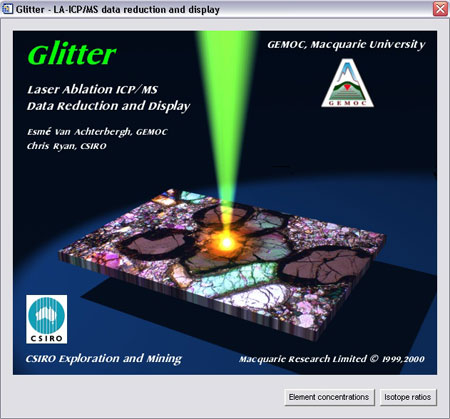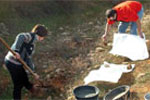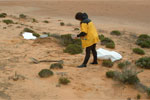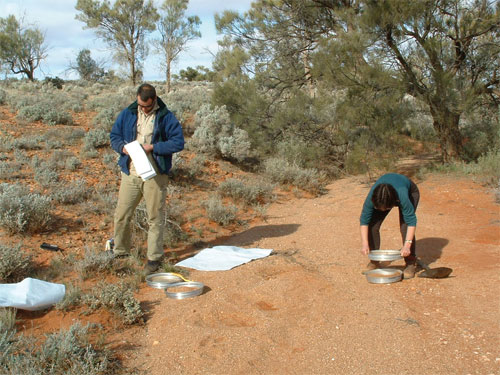Industry interaction, technology transfer and commercialisation program
Gemoc relies on a vigorous interaction with the mineral exploration industry at both the research and the teaching/training levels. The research results of the Centre’s work are transferred to the industry and to the scientific community by:
- collaborative industry-supported Honours, MSc and PhD projects
- short courses relevant to the industry and government sector users, designed to communicate and transfer new technologies, techniques and knowledge in the discipline areas covered by the Key Centre
- one-on-one research collaborations and shorter-term consultancies on industry problems involving national and international partners
- provision of high quality geochemical analyses and value-added interpretations to industry and government organisations, extending our industry interface
- use of Macquarie Research Limited consultancies, which employ and disseminate the technological developments carried out by the Centre
- GLITTER, an on-line data-reduction program for Laser Ablation ICPMS analysis developed by GEMOC and CSIRO GEMOC participantshas been successfully commercialised and is available commercially through New Wave Research (http://www.es.mq.edu.au/GEMOC/)
- collaborative relationships with technology manufacturers (more detail in the section on Technology Development)
- GEMOC (Macquarie) is the Agilent Technologies ICPMS Australian demonstration site
-
- GEMOC (Macquarie) is the international Alpha test site for New Wave Research Lasers

GLITTER - the industry standard for LAM-ICPMS online data reduction.
Support sources
GEMOC industry support includes:
- direct funding of research programs
- “in kind” funding including field support (Australia and overseas), access to proprietary databases, sample collections, digital datasets
- collaborative research programs through ARC Linkage Projects and the Macquarie University External Collaborative Grants (MUECRG) and PhD program support
- assistance in the implementation of GIS technology in postgraduate programs
- participation of industry colleagues as guest lecturers in undergraduate units
- extended visits to Macquarie by industry personnel for interaction and research
- ongoing informal provision of advice and formal input as members of the Advisory Board
Progress in 2003
Nine Industry Reports were completed for collaborative and consulting projects.
TerraneChronTM studies (see Research Highlights) have been adopted by a significant segment of the global mineral exploration industry. This methodology, currently unique to GEMOC, requires the integration of data from three instruments (electron microprobe, LAM-ICPMS and LAM-MC-ICPMS) and delivers fast, cost-effective information on the tectonic history (with ages) of regional terranes.
The ARC Linkage Project with WMC titled “Global Lithosphere Architecture Mapping” continued. Planning and workshop sessions at Macquarie with participants from WMC and GEMOC, and a visit by Macquarie staff to WMC in Perth, were key activities in 2004. Dr Graham Begg spent significant research time at GEMOC through 2004 as part of the close collaborative working pattern for this project.
Professor J. Harris (on behalf of de Beers) provided further samples for the PhD project of Sonal Rege aimed at developing a methodology for the trace-element analysis of diamonds.
A new collaborative project with Anglo American is investigating the isotopic composition of Cu, Fe and several other elements in sulfides and whole rocks from a major ore deposit.
Rio Tinto supplied samples and funding for a Macquarie University Collaborative Grant (2004) project that uses garnets, chromites and pyroxenes from kimberlites to study the composition of the lithospheric mantle beneath the Dharwar Craton of India.
A pilot study on detrital zircons from Paleozoic sediments was carried out with the New South Wales Geological Survey; the results were used to support a successful proposal for a Macquarie University Collaborative Grant (2004). The project is investigating the provenance of the Paleozoic sedimentary rocks of the western Lachlan Fold Belt.
A very successful project on Continental Flood Basalts related to Ni and PGE deposits was carried out with WMC and resulted in a new project commencing 2005, exploring a novel framework for the origin of magmatic Ni-deposits.
A new alliance with PIRSA (Primary Industries and Resources, South Australia) commenced in 2004 with a funded TerraneChronTM project.
GEMOC researchers presented invited and keynote addresses at the de Beers Diamond Conference in Warwick in July, 2004 and at the SEG in Perth in September. Both of these conferences had a large industry attendance.
Numerous industry visitors spent varying periods at GEMOC in 2003 to discuss our research and technology development (see visitor list, Appendix 3).
DIATREEM continued to provide LAM-ICPMS analyses of garnets and chromites to the diamond-exploration industry on a routine basis.
GEMOC publications, preprints and non-proprietary reports are available on request for industry libraries.
Current industry-funded collaborative research projects
THESE ARE brief descriptions of current GEMOC projects that have direct cash support from industry and timeframes of at least one year. Projects are both national and global.
GEMOC’s industry collaborative projects are designed to develop the strategic and applied aspects of the basic research programs based on understanding the architecture of the lithosphere and the nature of Earth’s geodynamic processes that have controlled the evolution of the lithosphere and its important discontinuities. Most of the industry collaborative projects rely on geochemical information from the Geochemical Analysis Unit in GEMOC and especially on novel methodologies developed by (and some unique to) GEMOC.
Geochemical data on crustal and mantle rocks are being integrated with tectonic analyses and large-scale datasets (including geophysical data) to understand the relationship between lithosphere domains and large-scale mineralisation.
The new methodologies of using mantle sulfides to date mantle events, and of characterising crustal terrane development using U-Pb dating and Hf isotopic compositions of zircons provides more information for integration with the geophysical modelling. TerraneChronTM (see Research Highlights) is proving an important new approach to characterising the tectonic history and crustal evolution of terranes on the scale of 10 – 100 km as well as delivering a cost-effective exploration tool to the mineral (and potentially petroleum) exploration industry.

Elena Belousova and Michael Schwarz from PIRSA collecting zircon TerraneChron samples during field work at the Gawler Craton for the collaborative GEMOC/PIRSA project.
Global Lithosphere Architecture Mapping
Supported by ARC Linkage (2004-2006)
Industry Collaborator: WMC Resources
Summary: Compositional domains in the subcontinental lithospheric mantle reflect the processes of continental assembly and breakup through Earth’s history. Their boundaries may focus the fluid movements that produce giant ore deposits. Mapping these boundaries will provide fundamental insights into Earth processes and a basis for the targeting of mineral exploration. We will integrate mantle petrology, tectonic synthesis and geophysical analysis to produce the first maps of the architecture of the continental lithosphere, to depths of ca 250 km. These maps will provide a unique perspective on global dynamics and continental evolution, and on the relationships between lithosphere domains and large-scale mineralisation.
|
|
|
Global Lithosphere Architecture Mapping
Supported by ARC Linkage (2004-2006)
Industry Collaborator: WMC Resources
Summary: Compositional domains in the subcontinental lithospheric mantle reflect the processes of continental assembly and breakup through Earth’s history. Their boundaries may focus the fluid movements that produce giant ore deposits. Mapping these boundaries will provide fundamental insights into Earth processes and a basis for the targeting of mineral exploration. We will integrate mantle petrology, tectonic synthesis and geophysical analysis to produce the first maps of the architecture of the continental lithosphere, to depths of ca 250 km. These maps will provide a unique perspective on global dynamics and continental evolution, and on the relationships between lithosphere domains and large-scale mineralisation.
|
|
|
Developing a geochronological framework for the Gawler Craton, South Australia
Supported by a matching Macquarie University Collaborative grant (2004-2005)
Industry Collaborator: PIRSA (Primary Industries and Resources, South Australia)
Summary: The aim of the project is to supply a geochronological framework for the evolution of the Gawler Craton of South Australia, by dating major Archean and Proterozoic magmatic and tectonic events across the Craton. At present, the geochronology of this large region is poorly known, and this is one main reason why the minerals industry is choosing better-known regions to explore. The development of a better geochronological base will support the industry partner’s goal of establishing an integrated tectonic model as an aid to mineral exploration, and provide new insights into crustal evolution.
|
|
|
Lithosphere mapping beneath the Dharwar Craton, India
Supported by a matching Macquarie University Collaborative grant (2004)
Industry Collaborator: Rio Tinto
Summary: The project uses major- and trace-element analysis of mantle-derived minerals in kimberlites to map vertical and lateral variations in the composition and thermal state of the lithospheric mantle across the Archean Dharwar Craton in central India. The kimberlites are 900-1200 million years old, and may provide information on a relatively unmodified lithospheric root. Comparison with geophysical data (today’s situation) will help to define the fate of this root during India’s northward movement after its separation from Gondwanaland. The results will be directly relevant to diamond exploration models for the Dharwar Craton, and for other areas in India.
|
|
|
Application of metal isotopes in exploration for magmatic nickel and volcanic-hosted copper deposits
Supported by a matching Macquarie University Collaborative grant (2004-2005)
Industry Collaborator: Anglo-American PLC
Summary: The major aim is to study, for the first time, the isotope geochemistry of Ni and Pd in a magmatic nickel deposit. Cu and Fe isotopic studies will also be carried out on a volcanic-hosted copper deposit. The aims are to determine whether isotopic data for commodity metals can be used to discriminate between barren and fertile host rocks and whether these isotopic ratios can provide vectors to ore within a mineralised system. The expected outcomes are development of new analytical methodologies and new isotopic exploration tools for blind ore deposits, which could be adopted by the Australian mineral exploration industry.
|
|
|
Continental Flood Basalts: geochemical discrimination with relevance to exploration for nickel and platinum-group elements
Supported by a matching Macquarie University Collaborative grant (2004)
Industry Collaborator: WMC Resources
Summary: A major proportion of magmatic Ni- platinum group element (PGE) deposits are hosted in mantle-plume-derived continental flood basalts (CFB). Therefore, geochemical discrimination of CFB from other mantle-derived rocks and identification of Ni-PGE-prospective CFB are significant for Ni-PGE exploration. This project is exploring existing geochemical databases for mantle-derived rocks to provide user-friendly practical discrimination parameters to identify CFB-related mafic rocks and to evaluate their Ni and PGE economic potential. The research will also further constrain the role of mantle plumes in formation and evolution of subcontinental lithosphere and the behaviour of sulfides during the process of mantle evolution.
|
|
|
Where was Baltica? Testing continental reconstructions with TerraneChronTM
Supported by a matching Macquarie University Collaborative grant (2003-2004)
Industry Collaborator: University of Oslo and Norwegian Geological Survey
Summary: Norway represents the western margin of the ancient landmass of Baltica, which was partly destroyed in the Caledonian Orogeny ~550-400 million years (Ma) ago. Its position before 600 Ma is debated. This project is using U-Pb dating and Hf-isotope analysis of zircons in basement rocks in SW Norway and in far-transported thrust sheets (nappes) derived from the vanished western margin of Baltica, to reconstruct the geological history of this margin. The results will allow evaluation of models for continental assembly, and will be relevant to studies of the provenance of sediments in the oil/gas basins of the North Sea.
|
|
|
Testing Ordovician-Devonian tectonic models for the Lachlan Orogen
Supported by a matching Macquarie University Collaborative grant (2004)
Industry Collaborator: NSW Geological Survey
Summary: This project combines the TerraneChronTM technology developed at GEMOC with tectonic and structural concepts developed at the Geological Survey of NSW, to understand the plate-tectonic evolution of SE Australia. U/Pb dating and Hf-isotope analysis of detrital and primary zircon grains will shed light on potential terrane accretion and on the timing of crustal growth and will be used to test published models of the Ordovician–Devonian tectonic development of Eastern Australia. This in turn will help to understand the nature of the interaction between the Australian plate and the proto-Pacific margin of the Gondwana supercontinent.
|
|
|
Improving Mineral Exploration Performance by Superior Management of Risk, Uncertainty and Value
Supported by Macquarie University Industry Collaborative Grant
Industry Sponsors: BHP Billiton, Codelco, Geoinformatics Exploration, Gold Fields, Jackaroo Drill Fund, Newmont, Placer Dome, Teck Cominco, WMC Resources.
Summary: Mineral exploration performance has deteriorated significantly over the past 15-20 years, especially with respect to the rate and cost of the large, ‘greenfields’ discoveries that generate so much value for the industry and underpin its future resource base. This research project is analysing past industry performance to identify opportunities for improvement, building probabilistic models of the mineral exploration business to provide a better decision framework, investigating the role of the high natural uncertainty and complexity on decision making, and developing a range of tools to improve risk and value management. The project involves collaboration between geoscientists, statisticians, psychologists and business management across the university.
|
|
[Back to top]
|







 GEMOC ARC National Key Centre
GEMOC ARC National Key Centre